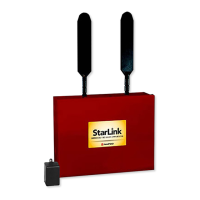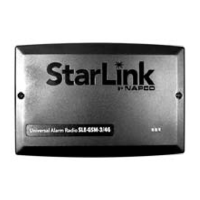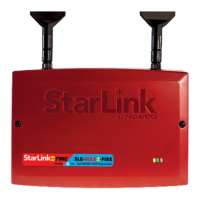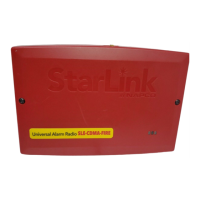StarLink
™
SLE Commercial LTEVI & LTEAI Series Dual-Path Alarm Communicators -- Installation Instructions 3
during each part of the process (dialing, handshaking,
data transmission, etc.).
RED TROUBLE LED
Labeled "D5", this LED is located at the bottom right of
the PC board. Operation is as follows:
1 Blink: Low Aux Power input voltage
2 Blinks: Battery trouble
3 Blinks: Alarm report Failed to Communicate (will
restore only when the communicator path is restored)
4 Blinks: RF trouble (antenna connection or cellu-
lar registration)
5 Blinks: Communicator poll or check-in failure
(radio and/or Ethernet). Either or both paths will trigger
the trouble, but for the trouble to clear, unit requires
both IP and communicator polling/checkins to be oper-
ational
6 Blinks: Unit disabled (reporting or control panel
downloading not allowed)
7 Blinks: Unit was shutdown and has no function-
ality; requires a restart (full power down and full power
up sequence) to restore operation
8 Blinks: Telco Line Cut
RED DIAGNOSTIC LED
Labeled "D7", this LED is located in the middle of the PC
board. One blink indicates a weak or non-existent signal
from the network (green LED is off). If this red LED is
blinking in any other manner, contact technical support.
GREEN IP NETWORK CONNECTION LED
Labeled "D14" (or DS14), this LED is located to the right
of the ETHERNET socket on the PC board. Operation is
as follows:
Off = No network cable detected
Fast Flash = No IP connection (Occurs just after pow-
er on, while trying to obtain a IP address)
Slow Flash = Normal IP network operation
1 Blink: Static IP
2 Blinks: DHCP
3 Blinks: Auto IP (If unable to acquire DHCP ad-
dress, then after 5 minutes it will convert to Auto IP
TB20: C OUT1: Common. Dry contact Form C relay.
Add shunt to lower two pins of JP1 for wet contacts
(connects relay Common to system ground). Relay
rated 30V AC/DC, 500mA.
TB21: N/C OUT1: Normally closed. Dry contact Form
C relay. Add shunt to lower two pins of JP1 for wet
contacts.
TB22: N/O OUT2: Normally open. Dry contact Form C
relay.
TB23: C OUT2: Common. Dry contact Form C relay.
Relay rated 30V AC/DC, 500mA.
TB24: N/C OUT2: Normally closed. Dry contact Form
C relay.
LED DESCRIPTIONS
The PC board contains several LED's, as follows:
GREEN RF SIGNAL STRENGTH LED
Labeled "D3", this LED is located at the lower right corner
of the PC board.
Every 30 seconds, the StarLink communicator receiver
section turns on and listens to the cell tower. Depending
on the signal strength detected, it will blink the Signal
Strength LED from 1 to 5 times, providing a signal
strength indicator that is updated constantly and is al-
ways displayed.
Green LED Operation
Signal strength (as received by the communicator) is dis-
played by this LED blinking 1 to 5 times at a constant rate
(with a short delay between blink cycles). Acceptable
power level is greater than or equal to 2 blinks.
YELLOW OPERATIONAL STATUS LED
Labeled "D4", this LED is located at the bottom right of
the PC board. Operation is as follows:
Normal Standby Condition:
Blinks on momentarily every 10 seconds: Unit is in
standby waiting for an alarm to report.
Processing Alarm Conditions:
When processing an alarm, this LED will blink variably
NOTICE TO AUTHORITIES HAVING JURISDICTION, USERS, INSTALLERS,
DEALERS, AND OTHER AFFECTED PARTIES
FIRE PROGRAMMING OPTION
PERMITTED IN
UL864? (Y/N)
AVAILABLE SETTINGS REQUIRED UL 864 SETTINGS
Unattended Remote Downloading No Enable / Disable
Disabled (Jumper 1 installed). Also required for Commercial installations. Note:
See page 7 "Configuration Download / Firmware Updates" for jumper instruc-
tions.
IN2 and IN3 Unsupervised Yes Supervised / Unsupervised
Unsupervised using conduit within 20 feet of FACP (default). If not using conduit,
install Jumpers 4 and 5 and EOL Resistors. Inputs 2 an 3 can be unsupervised
with jumpers 4 and 5 removed; IN4 and IN5 always require EOLR
7 Day Supervision, Radio to NOC No
200 seconds, 5 minutes, 6
minutes, 60 minutes, 6
hours, 7 days
200 seconds, 5 minutes, 60 minutes. 6 Hours permitted in Commercial Fire UL
864 with Dual Path enabled.
Trouble on Radio or IP Path
(Annunciate / Report)
Yes Either Path or Both Paths Either Path (annunciation and report of trouble)
Wi-Fi Module Yes Enable / Disable May be enabled as a primary reporting path for Fire
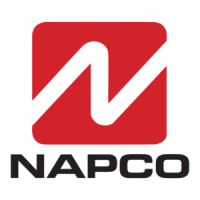
